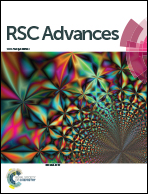An alternative technique for patterning cells on poly(ethylene glycol) diacrylate hydrogels†
Abstract
This work demonstrates the feasibility of patterning a poly(ethylene glycol) diacrylate (PEGDA) hydrogel with a cell adhesive ligand that was functionalized with an acrylate group using Michael type addition instead of activated N-hydroxysulfosuccinimide (NHS) ester based chemistry. We synthesized PEGDA from PEG molecules and made PEGDA hydrogels via free radical polymerization in the presence of UV light and photoinitiator. Mechanical and physical properties of the hydrogel could be tuned by changing the polymer concentration. The synthesized PEGDA was made to react with cysteine–glycine–arginine–glycine–aspartate–serine (CGRGDS) peptide in a controlled manner to yield acrylate-PEG–CGRGDS via base catalyzed Michael type addition reaction. This monoacrylated cell adhesive peptide was immobilized on inert PEGDA hydrogel surface by exposing it to UV light through a photomask to render the gels selectively adhesive to cells. Fluorescently tagged CGRGDS peptide was used to enable visualization of patterned regions under a fluorescence microscope. Conjugation of acrylated peptide to PEGDA gel post UV exposure was determined by acid hydrolysis followed by ninhydrin assay. Primary human dermal fibroblast cells were found to adhere and spread on the surface of gels patterned with peptide, thereby, confirming that selective cell adhesion can be achieved by this method. Here, we demonstrate a cost effective way to form a monoacrylated cell adhesive peptide that can be used for spatial patterning of cells on an acrylated hydrogel surface.


 Please wait while we load your content...
Please wait while we load your content...